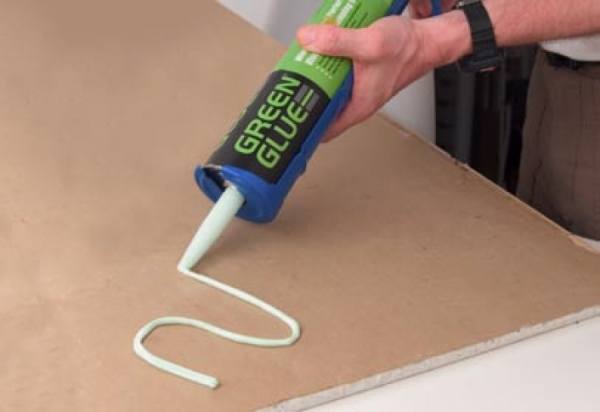Clients often ask me this question. They want to know an unbiased recommendation which soundproofing product they should use for maximum noise reduction and soundproofing effectiveness. Is it Green Glue, QuietRock or SilentFX? To find out my answer, read on.
More...
Comparing Green Glue, QuietRock and SilentFX acoustical test data
The test data referenced below is provided by manufacturers, Green Glue Company and PABCO Gypsum, the manufacturer of QuietRock and CertainTeed, the manufacturer of SilentFX. They both provide test reports commissioned from reputable third party acoustical test laboratories. The table below compares STC (Sound Transmission Class) values for four pairs of comparable assemblies. Note that I consider two layers of drywall with Green Glue between layers comparable to one layer of QuietRock or SilentFX.
Green Glue Assembly | STC | Ref | QuietRock or SilentFX Assembly | STC | Ref |
|---|---|---|---|---|---|
Steel, Green Glue on one side only: 5/8" Drywall Green Glue Compound 5/8" Drywall Steel 3-5/8" Studs // 24" o/c R13 Fiberglass 5/8" Drywall | 56 | [1] | Steel, QuietRock or SilentFX on one side only: 5/8” QuietRock ES Steel 3-5/8" Studs // 24" R13 Fiberglass 5/8" Drywall | 55 | [2] |
Steel studs, GG on both sides: 5/8" Drywall Green Glue Compound 5/8" Drywall Steel 3-5/8" Studs // 24" o/c R13 Fiberglass 5/8" Drywall Green Glue Compound 5/8" Drywall | 61 | [3] | Steel studs, QR on both sides: 5/8” QuietRock ES Steel 3-5/8" Studs // 24" o/c R13 Fiberglass 5/8” QuietRock ES | 57 | [4] |
Wood, staggered studs: 5/8" Drywall Green Glue Compound 5/8" Drywall Wood 2" x 4" Staggered Studs // 16" o/c R13 Fiberglass 5/8" Drywall Green Glue Compound 5/8" Drywall | 62 | [5] | Wood, staggered studs: 5/8" QuietRock ES Wood 2" x 4" Staggered Studs // 16" o/c R13 Fiberglass 5/8" Drywall 5/8" Drywall | 60 | [6] |
Wood studs: 5/8" Drywall Green Glue Compound 5/8" Drywall Wood 2" x 4" Studs // 24" o/c 5/8" Drywall Green Glue Compound 5/8" Drywall | 56 | [7] | Wood studs: 5/8” QuietRock ES Wood 2" x 4" Studs // 24" o/c 5/8” QuietRock ES | 54 | [8] |
Test data references:
[1] GG test data 2
[3] GG test data 3
[5] GG test data 1
[7] GG test data 1a
[9] SilentFX
Note: Since this article was published, Green Glue Company removed acoustical test data from the internet.
Other differences between the two products
Green Glue Assemblies | Noise Reducing Board Assemblies |
|---|---|
Test data is available with resilient channels and resilient clips on walls, showing improved noise attenuation with resilient mounting [9] | QuietRock is not recommended over resilient channels on walls [10], while SilentFX allows resilient channels [9]. |
Can be used with resilient channels on ceilings [11] | Can be used with resilient channels on ceilings [12] |
Has increased noise attenuation at low frequencies by 2-3 dB versus similar assemblies with the other product.[13]. | Has reduced noise attenuation at low frequencies by 2-3 dB versus similar assemblies with the other product [13]. |
References for other differences:
[9] Resilient channels with GG
[10] Resilient channels with QR
[11] Ceilings with GG
[12] Ceilings with QR
[13] Information obtained by inspection of detailed attenuation data per frequency.
Note: Since this article was published, Green Glue Company removed acoustical test data from the internet.
Conclusion
The acoustical test data for comparable assemblies shows small advantage of using Green Glue, particularly at low frequencies. However, for most test assemblies the advantage of Green Glue is small, within a measurement error. It is up to the individual contractor to make an installed cost analysis and chose the product that can be installed more economically.
There are many more assemblies available with test data for each product, but the assemblies are not directly comparable. I therefore recommend using the most suitable assembly with available test data that meets client’s objectives, whether it is with Green Glue, QuietRock or SilentFX.
The manufacturers for SilentFX and QuiteRock provide tested assemblies that are different from the competitor's assemblies, making precise comparison difficult. However, both products function on the same physical principle and are functionally identical.
If you have questions or comments submit your feedback using the form below. If you would like to request a soundproofing advice or quote for a renovation, please use the button below.
